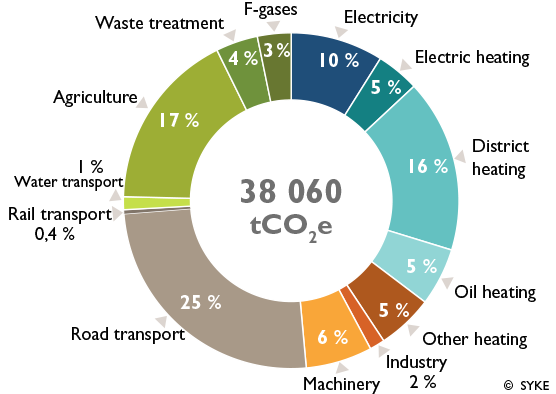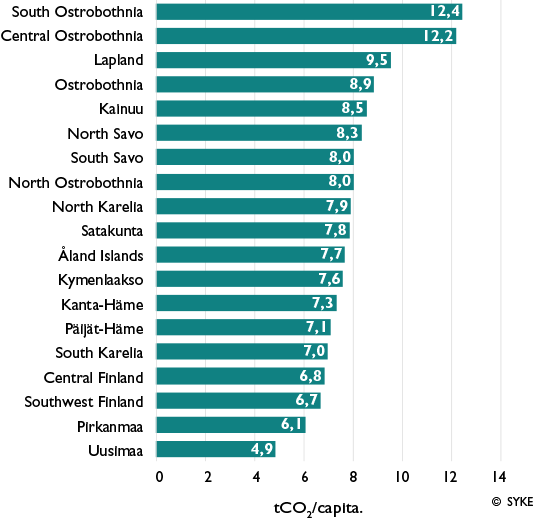
The total greenhouse gas emissions of Finnish municipalities by sector in 2005–2018 Emissions have been calculated in accordance with the Hinku calculation rules. © SYKE
According to a recent calculation by the Finnish Environment Institute (SYKE), municipal climate emissions increased by 0.6 per cent in 2018 compared to the previous year. On average, emissions from transport, agriculture and district heating remained at the level of 2017, but emissions from electricity were higher than before because of the increased emissions of Finnish electricity production. However, there are considerable differences between municipalities in the distribution of emissions to different sectors and their development.
Over the longer term, emissions have decreased in almost all Finnish municipalities. The average change over the period 2005–2018 has been -15 per cent. Municipalities’ emissions have significantly reduced due to the replacement of oil heating with other forms of heating, the decrease of natural gas and oil in district heating production, and the construction of wind power. Electricity emissions have also decreased during this period as a result of cleaner electricity production.
The Finnish Environment Institute has calculated the amount and development of climate emissions for all Finnish municipalities using a uniform calculation method. The results of the ALas calculation model (ALas 1.0) published in February were now updated for 2005–2018.
In 2018, the main sources of emissions in Finnish municipalities included road transport (25 %), agriculture (17 %), district heating (16 %) and electricity consumption (heating and other consumer electricity 15 %). Electricity emissions were higher than in the previous year due to the increased electricity demand of the industry, higher heating needs in winter 2018 and the scarce supply of hydropower.
Distribution of total municipal emissions in 2018

Distribution of total municipal emissions in 2018. Emissions have been calculated in accordance with the Hinku calculation rules. © SYKE
The Hinku calculation supports municipal climate work
Hinku calculation rules are applied in the default calculation for monitoring municipal targets. In the Hinku calculation, efforts have been made to exclude factors that the municipalities are unable to influence. Thus, a major part of the industries and drive-through traffic are excluded from the calculation. Emissions from electricity consumption are calculated according to the average emissions from electricity produced in Finland. Wind power is taken into account separately by calculating an emission compensation for the municipalities producing wind power.
Additionally, it is also possible to examine the results of the ALas model without the Hinku calculation filters, without wind power compensation as well as separately in the emissions trading and effort-sharing sectors. Municipal emissions calculations do not include industrial process emissions or the land use sector (LULUCF) included in the Finnish greenhouse gas inventory.
“The Hinku calculation aims at fairness, encouragement and comparability, but the emissions from all industry and drive-through traffic are also worth taking into account when examining the results. On the other hand, in wind power intensive or agricultural municipalities, for example, the emissions trends can be monitored completely without wind power compensation or agricultural emissions. In this case, the effect of other factors on emissions will be more visible,” says Johannes Lounasheimo, Senior Specialist in municipal emissions calculation at SYKE.
Greenhouse gas emissions per capita in the regions in 2018

Greenhouse gas emissions per capita in the regions in 2018. Emissions have been calculated in accordance with the Hinku calculation rules. © SYKE
Increasingly accurate estimate of different sources of emissions
SYKE's emission calculation system ALas covers all Finnish municipalities and 80 emission sectors. Emissions and energy consumption are calculated annually for all municipalities and sectors. The calculation model is updated as necessary; for example, on the basis of available new source data.
The most significant updates of the calculation method in the now published ALas 1.1, which affected the results, were made to the emissions calculations of industry, water transport and agriculture. Agricultural emissions were recalculated for the whole reference period 2005–2018 and the sectoral breakdown was developed.
Much industrial source data and the division between the emissions from the heating of industrial properties and other industrial emissions were clarified. The calculation of water transport specified the allocation of emissions from boats and ferries as well as cargo ships to individual municipalities.
The calculation criteria for all sectors have been introduced in detail in a recent report on the calculation of Finnish municipal greenhouse gas emissions (Suomen kuntien kasvihuonekaasupäästöjen laskenta) with a method description of the ALas model and results of the calculations from 2005–2018 (link).
“It is important that all municipalities now have emission estimates made on a uniform basis and that the development and trends can be monitored annually as Finland strives for carbon neutrality in 2035. The documented calculation system also supports the planning and implementation of municipal emission reduction measures. There is a need to activate municipal climate measures as the total emissions of municipalities have not decreased much in the last five years,” says Professor Jyri Seppälä at SYKE.
The municipal emissions calculation system has received funding from the Ministry of the Environment (ALas project), the Association of Finnish Local and Regional Authorities and the EU Life IP Canemure project in which Sitra acts as a national co-financier for emissions accounting. The results for 2019 and preliminary data for 2020 will be published in the spring 2021.
All the results are openly available:
Graphs
Further information
- Johannes Lounasheimo, Senior Specialist, Finnish Environment Institute, tel. +358 29 525 1963, firstname.lastname@ymparisto.fi
- Santtu Karhinen, Researcher (Road transport, etc.), Finnish Environment Institute, tel. +358 29 525 1889, firstname.lastname@ymparisto.fi
- Juha Grönroos, Senior Research Scientist (Agriculture), Finnish Environment Institute, tel. +358 29 525 1128, firstname.lastname@ymparisto.fi
- Hannu Savolainen, Researcher (Rail and water transport), Finnish Environment Institute, tel. +358 29 525 1839, firstname.lastname@ymparisto.fi
- Tommi Forsberg, Coordinator (F-gases), Finnish Environment Institute, tel. +358 29 525 1116, firstname.lastname@ymparisto.fi
- Professor Jyri Seppälä, leader of the HINKU network, Finnish Environment Institute, tel. +358 29 525 1629, firstname.lastname@ymparisto.fi